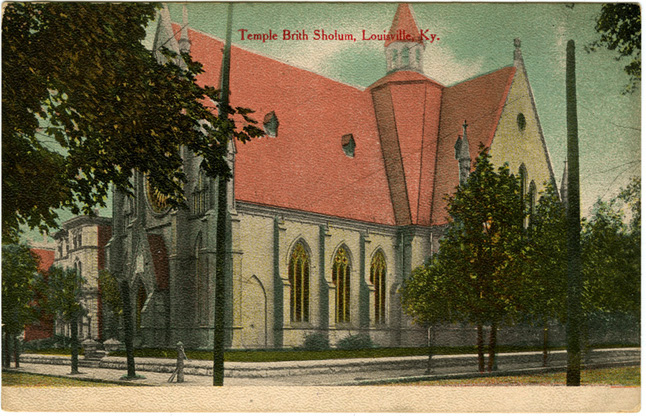2.6 Louisville, Kentucky
Temple Brith Sholom, 753 S. 2nd Street
Architect and date unknown; former College Presbyterian Church acquired in 1903
Bagby-Howe Drug Company, Louisville, Kentucky, publisher; no date
Numerous synagogues resemble Gothic–style churches, but this postcard of Temple Brith Sholom (Covenant of Peace) in Louisville, Kentucky, depicts one of the many Jewish houses of worship that found a home in an actual Christian church. Formerly College Presbyterian Church, this sanctuary served Brith Sholom from 1903 to 1950.
The congregation had erected its first building on 1st Street in 1882, just a year after it was established by largely German-speaking Reform-minded immigrants. In 1903, having outgrown that building, its membership moved into the former church.
Jewish congregations frequently used former church buildings as synagogues, especially as starter buildings when they lacked funds to build a new structure designed to suit Jewish needs. Of necessity, these congregations adapted to the spatial and decorative environments of church architecture. Especially in the Midwest, many of these repurposed churches were Gothic in style, having been erected in the mid-19th century by Scottish Presbyterians and German Lutherans.
The case of Brith Sholom in Louisville is unusual, since the congregation moved from its own building into an already existing structure. The first synagogue is known only from one exterior view, published in a newspaper. The image shows a unique design that included Gothic elements: a large central pointed arch, lancet windows, and finials along the upper facade. When it outgrew that structure, the congregation decided—probably because of cost—to adapt a former church rather than build a new sanctuary, relocating from one Gothic-style house of worship to another. On the outside only slight changes were made: The Ten Commandments were installed over the door and the Star of David was placed atop the front gable, where perhaps a cross had been.
Across the country it was not unusual for Jews to purchase former churches for synagogue use, and in Kentucky this seems to have been especially common. Other Kentucky congregations that occupied church buildings at some point in their history include B’nai Jacob in Louisville, which acquired a former church in 1891, then tore it down circa 1900 and built a new synagogue in its place; the United Hebrew Congregation in Newport, which in 1905 moved into a former Christian church; and the Orthodox Beth Hamedrash Hagodol in Louisville and Reform Temple Adath Israel in Lexington, which in the same year acquired former German Lutheran churches to use as synagogues. In 1914, Lexington’s Ohavay Zion moved into what had previously been a Presbyterian church, and, in 1917, Louisville’s Agudath Achim moved into a building that had been erected as St. John’s Episcopal Church.
